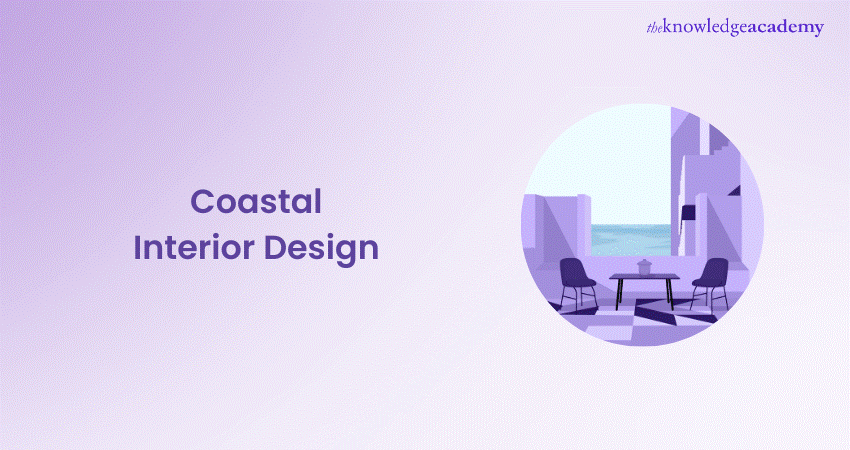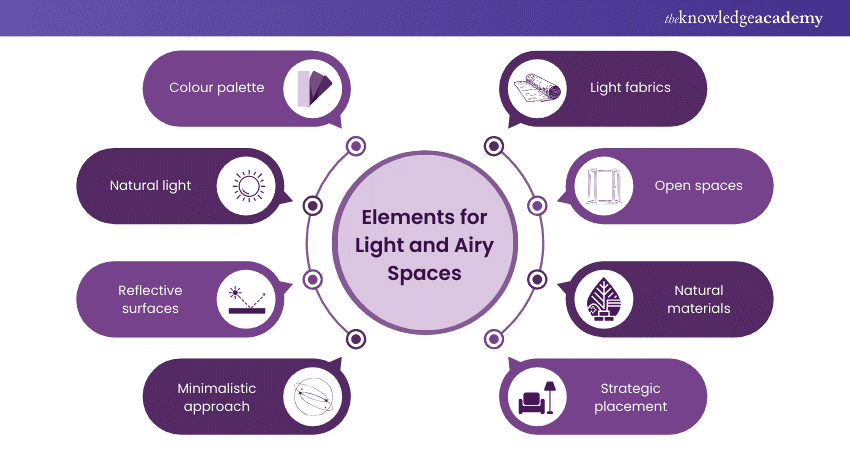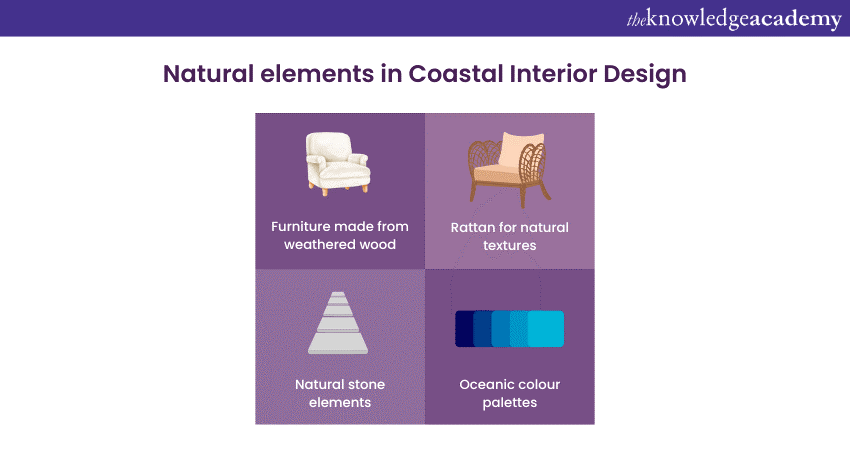We may not have the course you’re looking for. If you enquire or give us a call on +1800812339 and speak to our training experts, we may still be able to help with your training requirements.
Training Outcomes Within Your Budget!
We ensure quality, budget-alignment, and timely delivery by our expert instructors.

Interior Design is the skill of creating not only a beautiful environment but also using our living spaces efficiently. There are many famous and popular Interior Designs, of which Coastal Interior Design is by far one of the most desired forms.
Influenced by the calmness of the seashore, Coastal Interior Design style brings together the soothing feel of the beachy atmosphere in your home. This Interior Design style majestically integrates the soothing effects of nature with beautiful aesthetics and brings a feeling of calmness and peace.
So, if you are interested in continuing the discovery of this kind of interior design, read this blog, which will help you become acquainted with the key aspects and advantages of coastal interior design. Read ahead to learn more!
Table of Contents
1) What is Coastal Interior Design?
2) Key elements of Coastal Interior Design
a) Light and airy spaces
b) Nautical and beach-inspired décor
c) Incorporating natural elements
d) Open and relaxing layouts
3) Benefits of Coastal Interior Design
4) Conclusion
What is Coastal Interior Design?
Coastal Interior Design is a style that absorbs the chill and smooth essence of coastal living. Both natural elements and soft visual aspects in interior spaces could achieve this. Rooted in the beauty of coastal landscapes, this tactic visualises the peace of seaside living. The implementation of natural light maximisation and the development of comprehensive and free spaces promote a coastal atmosphere which is breezy and open.
Furniture and decor are meticulously chosen to resemble the textures and scale of the sea. The furniture, including weathered wood, wicker, and rattan, evokes the weathered appearance of driftwood.
At the same time, nautical accents like ropes, shells, and marine-themed artwork infuse maritime charm. The Coastal Interior Design style goes beyond geographical limitations, offering a universal appeal that brings the calm and freshness of the coast to homes, regardless of their location.
Key elements of Coastal Interior Design
To help you better understand the nuances of this design, the following are some key elements that are important to Coastal Interior Design style:
Light and airy spaces
The design principle of lightness is achieved through various elements and techniques that harmoniously evoke a sense of openness and relaxation. These elements are as follows:

1) Colour palette: The colours gently predominate in a soft palette, such as blue, white, beige, and soft pastels. It's as if these colours reflect the natural shades of the water, sky and sandy beaches, creating the coastal aesthetic. Some similar colour palettes can be used in Scandinavian interior design.
2) Natural light: Natural light is a necessity. Large openings, transparent material, and walls invite daylight through the windows, creating an outgoing and joyful ambience.
3) Reflective surfaces: Glossy finishes, mirrors, and glass helps diffuse light within the room by creating an illusion of space and brightness.
4) Minimalistic approach: Clutter is eliminated to create a free-flowing ambience. This achieves relaxation and freshness, enabling the inhabitants to breathe freely and comfortably.
5) Light fabrics: Curtains, sofas, and duvets are light, open materials that move up and down in the wind. This brings complete visual effects and makes the room smoother and softer.
6) Open spaces: Coastal Interior Design style is characterised by an open plan with no compartmentalisation, allowing a smooth transition from one room to another. Open spaces demolish visual obstacles and let light move freely through the atmosphere.
7) Natural materials: Bringing in natural materials such as light wood, rattan, and hemp will enhance the sense of tranquillity and spaciousness within the area.
8) Strategic placement: The furniture pieces and the decorations are tactically spaced to allow sunlight unhindered.
Nautical and beach-inspired décor
This decor design idea shows the true character and style of Coastal life by adding design elements that depict the ocean's beauty and the coast's peaceful nature.
1) Nautical accents: Sailors' rope details, ship wheels, anchors, and portholes are the most common decorative components that give an interior a unique maritime air.
2) Seashells and marine life: Seashells, starfish, and coral motifs are used as decorations in framed artworks, sculptures, and even lamp bases. Their presence merges the natural beauty of the underwater into our indoor spaces.
3) Weathered wood: The furniture and accessories made of worn or recycled wood evoke the driftwood found on the shore. These elements impart the space a rustic and coastal look.
4) Stripes and patterns: Sailor's stripes are a recurring motif in cushions, blankets, and rugs. These designs symbolise a traditional sea fashion.
5) Marine artwork: Paintings, prints, and photographs representing ocean scenes, sailboats, and lighthouses offer a visual connection with the sea and aid in developing the theme.
6) Nautical colours: The navy blue, crisp white, and aqua shades of the colour palette reflect the ocean and contribute to the coastal environment.
7) Lighthouse décor: Lighthouse décor items, such as lamps and figurines used for decorative purposes, remind of iconic coastal features and add a certain maritime history to the space.
8) Seafaring accessories: Vintage instruments for navigation, compasses, and telescopes fill the room with uniqueness and initiate exciting conversations.
Incorporating natural elements
The idea is to build interior space, expanding the greenhouse effect and dissolving a boundless relationship between the internal space and nature. Here's how the integration of natural elements contributes to the essence of Coastal Interior Design:

1) Weathered woods: Textures and materials such as crafted furniture and furniture made of old or reclaimed wood bring in the element of rural sultry. The woods mimic a worn-like surface of driftwood found around the Coastal region.
2) Natural textures: Rattan, wicker, jute, and sisal are among the most common nature-inspired materials that bring the texture of marine grasses to interiors. They add an extra edge and give the space a warm feeling.
3) Seagrass and hemp: These are mainly used for rugs, lampshades, and baskets. Each item is hand-woven and reflects the creativity and natural beauty of the artisans. Using seagrass and hemp, people can sense the morning dew and the river's ripples.
4) Stone and pebbles: Features such as a fireplace wall or an accent wall that come from the stones of the shore help create the rocky shore scenery. Among decorative items, we have pebbles and stones that can also be arranged in vases and bowls.
5) Plant a life: Pots of flowers, especially those that withstand coastal conditions, add a dash of nature to her stay indoors. The beach birds inundate Oceanside with their singing and dancing, creating a fresh and sparkling environment.
6) Ocean-inspired hues: To underline the Coastal environment, we created a pastel colour scheme for this place using shades of blue, green, and sandy neutrals, which will help us create a tranquil ambiance.
7) Shells and sea treasures: The collection displayed to represent the coastal area, with shells, starfish, and other treasures collected from the beach, will bring a real touch and connection to the sea.
8) Water-themed art: Pictures related to oceans, such as waves, seas, fish, and more, enhance the natural ambiance and make ocean organisation prominent.
Unlock Your Design Potential with AutoCAD Courses Today!
Open and relaxing layouts
This design concept centres around creating spaces that encourage seamless movement and evoke a sense of tranquillity. Here's how open and relaxing layouts contribute to the coastal design experience:
1) Flow and connection: Open layouts eliminate barriers between rooms, promoting a natural flow that mimics the ease of strolling along a beach. This interconnectedness fosters a sense of unity within the space.
2) Unobstructed views: Strategic placement of furniture and décor ensures that sightlines remain clear. It allows occupants to enjoy panoramic views of the interior and, if applicable, outdoor surroundings.
3) Maximised natural light: Prolonged glass walls separated by overhead windows illuminate the space, making it brighter naturally. Space has become a medium for channeling a warm, lighthearted sensation common to marine contexts. Consequently, the atmosphere here resembles a sunny coastal environment.
4) Breathe-easy atmosphere: You need to say no to clutter, and a new minimalist style will help you be calmer and relaxed. This enables people to breathe fully and wholly within space. In other words, openness allows them to have the right place in the air to be the crux of vitality and freedom.
5) Casual seating arrangements: A relaxing environment with chaise lounges, benches, and cosy chairs fosters relaxation and communication. Incorporating a Coastal Design implies filling the living room with broad sofas, soft back cushions, and deep seating chairs that allow guests to sit back and relax.
6) Multi-functional spaces: Open rooms that allow different activities, such as cooking, dining, lounging, and social life, to be in the same spot are a great decor idea because they make the space versatile and interactive.
7) Natural transitions: Using natural fabric such as wood and coastal-themed accessories instead of a solid wall creates a feel like the inside and outside are connected. These role changes aid in creating a prominent experience that is not only full but also encompassing.
8) Spatial balance: The layout strives for a harmonious balance between openness and cosy nooks. The spatial balance allows occupants to have private retreats within the more significant, inviting environment.
Increase designing your skills with our AutoCAD Certification. Register today!
Benefits of Coastal Interior Design
Coastal Interior Design offers more than just beauty. It provides a rich and positive experience where the body, mind, and soul are tuned for happiness.
1) Relaxation and tranquillity: Coastal style's soothing colour shades, natural textures, and open floor plan design, this type of room where you can relax in your mind. Ocean ambience is designed to emulate the rhythmic harmony of the coastal lifestyle, thereby creating a tranquil shelter from the turbulent tides of the surrounding environment.
2) Connection to nature: Using nature elements, colours, and symbols, the beauty of art can relate strongly to nature. It strengthens bonds that improve one's mental health and reduce stress.
3) Positive mood and mindset: Such spaces, in addition to the use of soft shades, which are in tune with nature, enhance positive emotions and have a general brightening effect on the atmosphere. Spending time in environments that echo the ocean life creates a positive mood and mindset.
4) Sense of serenity: The simple aesthetic of Coastal Design involves decluttering the surroundings, which leads to the creation of a peaceful and unwanted mess-free living space. An organised environment provides a sense of serenity and allows the mind to flourish.
5) Versatility: The Coastal Interior Design style is flexible, fitting different spaces. The spaces will have open layouts and furniture that is adaptable to support various situations and preferences. It is, therefore, up to the discretion of the homeowner to put it in urban apartments, suburban homes, or even as a vacation retreat.
6) Healthy living environment: In this Interior Design, light and natural materials are prioritised the most. Indoor plants also create a healthier residential environment. Researchers found that sufficient sunlight, air with no toxic elements, and green trees are beneficial for air quality and people's well-being.
7) Timelessness: Coastal design's timelessness keeps the space in the perpetual mood of relevancy and freshness and prevents it from being monotonous. It also implies that sustainable materials used in this type of design are perfect for individuals who pursue sustainable fashion, beauty, and style.
8) Personal connection: Incorporating elements like seashells or nautical décor can evoke memories of beach vacations, enhancing the sense of nostalgia and personal attachment to the space.
Conclusion
Coastal Interior Design offers a holistic haven that fosters relaxation, connection to nature, and a positive state of mind. Light-filled spaces, natural elements, and an open layout create a timeless and soothing retreat, enriching lives with tranquillity and coastal charm.
Unleash your creativity with our 3DS Max Training. Join now!
Frequently Asked Questions

Beachy decor often features bold, vibrant colours and playful beach-themed elements like surfboards and beach umbrellas. In contrast, Coastal decor uses a softer palette of blues, greens, and neutrals to evoke a calm, serene environment.

Incorporate bright, tropical colours such as turquoise, coral, and sunny yellow to give your house a beachy look. Use light, natural fabrics and add beach-themed decor like seashells, starfish, and nautical stripes.

The Knowledge Academy’s Knowledge Pass, a prepaid voucher, adds another layer of flexibility, allowing course bookings over a 12-month period. Join us on a journey where education knows no bounds.

The Knowledge Academy takes global learning to new heights, offering over 30,000 online courses across 490+ locations in 220 countries. This expansive reach ensures accessibility and convenience for learners worldwide.
Alongside our diverse Online Course Catalogue, encompassing 17 major categories, we go the extra mile by providing a plethora of free educational Online Resources like News updates, Blogs, videos, webinars, and interview questions. Tailoring learning experiences further, professionals can maximise value with customisable Course Bundles of TKA.

The Knowledge Academy offers various Office Applications Courses, including Interior Design Course, AutoCAD Course, Autodesk Inventor Training. These courses cater to different skill levels, providing comprehensive insights into Interior Design.
Our Office Applications Blogs cover a range of topics related to Automation Testing offering valuable resources, best practices, and industry insights. Whether you are a beginner or looking to advance your knowledge on Automation Testing, The Knowledge Academy's diverse courses and informative blogs have you covered.
Upcoming Business Skills Resources Batches & Dates
Date
 Interior Design Course
Interior Design Course
Fri 3rd Jan 2025
Fri 28th Mar 2025
Fri 23rd May 2025
Fri 4th Jul 2025
Fri 5th Sep 2025
Fri 24th Oct 2025
Fri 5th Dec 2025







 Top Rated Course
Top Rated Course



 If you wish to make any changes to your course, please
If you wish to make any changes to your course, please


